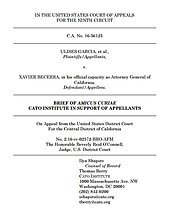Garcia v. Becerra
Learn more about Cato’s Amicus Briefs Program.
California law generally bans the possession of a gun within a school zone. For many years, however, both retired peace officers and those with a license to carry concealed weapons were exempted from this ban. Then in 2015, a bill was proposed that would have eliminated both of these exceptions. But after extensive lobbying by interest groups aligned with federal workers and police officers, the bill was amended to remove only the exception for concealed-carry licensees. Dr. Ulises Garcia is one such license holder, who obtained his license after receiving threats against himself from a former patient. After the change in the law, Garcia can no longer carry his weapon for protection when attending school events with his family. Garcia and a group of other plaintiffs have sued, arguing that the differing treatment afforded to retired peace officers and concealed-carry license holders violates the Fourteenth Amendment’s guarantee of the equal protection of the laws. The federal district court rejected their claims, and they have now appealed to the U.S. Court of Appeals for the Ninth Circuit. Cato has filed an amicus brief supporting Garcia and urging that the district court be reversed. In rejecting Garcia’s equal-protection arguments, the district court fundamentally erred in its application of an important Supreme Court test. Legislation that treats two groups unequally must be struck down if the enacting legislature was motivated by an impermissible purpose. This includes enacting a law solely to harm a politically unpopular group at the expense of a popular and powerful one. Yet despite plenty of evidence that this is exactly what occurred here, the district judge dismissed the “improper motivation” claim in a single paragraph, writing that the court could not find evidence of bad motives in the “legislative history of the Act” and that it could not rule for Garcia without “evidence of explicit legislative intent to cause harm to civilian gun owners. This approach dangerously narrows the universe of evidence that judges must examine to determine legislative motivation. As we explain in our brief, the Supreme Court has consistently examined all available evidence in this search, not just the narrow record produced by legislative history. Relying only on floor statements and committee reports, as the district court did, would allow legislators to easily hide their true motivations by simply holding their tongues. Actions speak louder than words, and in this case the actions of the law itself are evidence that its true motivation could not have been good-faith policy concerns. The Ninth Circuit should apply the correct test, examine all available evidence, and strike down this unequal treatment of a politically unpopular group.



